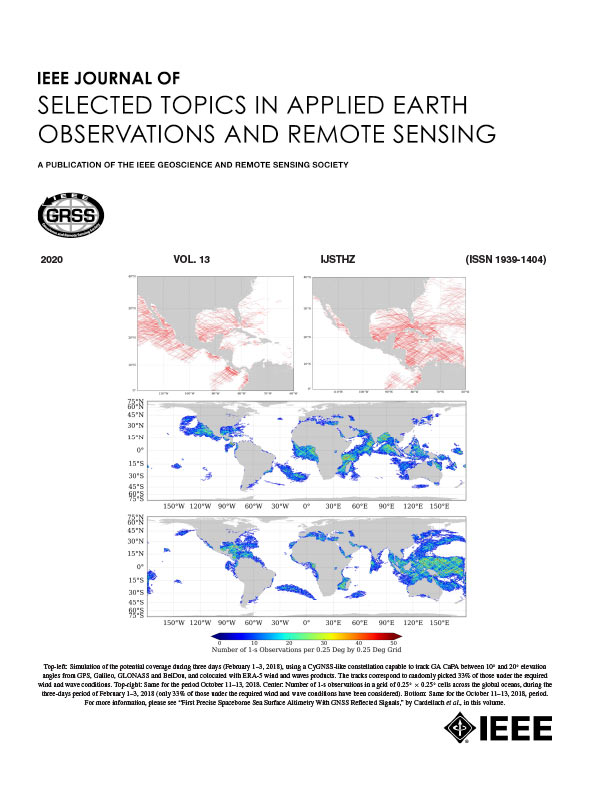Hyperspectral Anomaly Detection by Spatial–Spectral Fusion Based on Extreme Value-Entropy Band Selection and Cauchy Graph Distance Optimization
IF 4.7
2区 地球科学
Q1 ENGINEERING, ELECTRICAL & ELECTRONIC
IEEE Journal of Selected Topics in Applied Earth Observations and Remote Sensing
Pub Date : 2025-06-20
DOI:10.1109/JSTARS.2025.3581700
引用次数: 0
Abstract
Hyperspectral technology for detecting camouflaged targets in complex backgrounds represents a current research hotspot. Hyperspectral data often contain numerous spectral bands, which can lead to data redundancy. Traditional anomaly detection methods typically assume that the background spectrum follows a Gaussian distribution, which limits their adaptability to complex and non-Gaussian backgrounds. Furthermore, most existing anomaly detection methods fail to fully leverage the spatial information in hyperspectral images. To address these challenges, we propose a hyperspectral anomaly detection by spatial–spectral fusion based on extreme value-entropy band selection and Cauchy graph distance optimization (EBS-CGD). First, to effectively reduce the redundant bands in hyperspectral images, we introduce a hybrid band selection algorithm. This algorithm combines spectral extremum detection with information entropy filtering to select the most representative bands by considering multidimensional information. Second, to enhance the model’s adaptability to non-Gaussian backgrounds and maximize spectral information utilization, we propose a Cauchy graph distance-optimized RX anomaly detection approach. This method replaces the traditional covariance matrix with a significance-weighted Cauchy distance graph, reducing the influence of the target on the background and improving the model’s robustness in complex environments. Subsequently, a low-rank and sparse representation model is employed to construct background dictionaries, low-rank coefficient matrices for the background, and sparse anomaly matrices, enabling effective spatial information utilization for detecting anomalous targets. Finally, to fully exploit spatial–spectral information, we employ a weighted fusion of the detection results to reduce false positives and retain more true anomalies. We tested the proposed method on four real hyperspectral camouflage net datasets, each containing 126 bands. Experimental results demonstrate that the proposed EBS-CGD algorithm outperforms other methods in anomaly detection performance.基于极值熵波段选择和柯西图距离优化的空间光谱融合高光谱异常检测
复杂背景下伪装目标的高光谱检测技术是当前的研究热点。高光谱数据通常包含多个光谱波段,这可能导致数据冗余。传统的异常检测方法通常假设背景谱服从高斯分布,这限制了它们对复杂和非高斯背景的适应性。此外,现有的异常检测方法大多不能充分利用高光谱图像中的空间信息。为了解决这些问题,我们提出了一种基于极值熵波段选择和柯西图距离优化(eb - cgd)的空间光谱融合高光谱异常检测方法。首先,为了有效地减少高光谱图像中的冗余波段,引入了一种混合波段选择算法。该算法将谱极值检测与信息熵滤波相结合,通过考虑多维信息选择最具代表性的频带。其次,为了增强模型对非高斯背景的适应性,最大限度地利用光谱信息,提出了一种Cauchy图距离优化的RX异常检测方法。该方法用重要度加权柯西距离图代替传统的协方差矩阵,降低了目标对背景的影响,提高了模型在复杂环境下的鲁棒性。随后,采用低秩稀疏表示模型构建背景字典、背景低秩系数矩阵和稀疏异常矩阵,有效利用空间信息检测异常目标。最后,为了充分利用空间光谱信息,我们对检测结果进行加权融合,以减少误报并保留更多的真实异常。我们在四个真实的高光谱伪装网数据集上测试了该方法,每个数据集包含126个波段。实验结果表明,提出的EBS-CGD算法在异常检测性能上优于其他方法。
本文章由计算机程序翻译,如有差异,请以英文原文为准。
求助全文
约1分钟内获得全文
求助全文
来源期刊
CiteScore
9.30
自引率
10.90%
发文量
563
审稿时长
4.7 months
期刊介绍:
The IEEE Journal of Selected Topics in Applied Earth Observations and Remote Sensing addresses the growing field of applications in Earth observations and remote sensing, and also provides a venue for the rapidly expanding special issues that are being sponsored by the IEEE Geosciences and Remote Sensing Society. The journal draws upon the experience of the highly successful “IEEE Transactions on Geoscience and Remote Sensing” and provide a complementary medium for the wide range of topics in applied earth observations. The ‘Applications’ areas encompasses the societal benefit areas of the Global Earth Observations Systems of Systems (GEOSS) program. Through deliberations over two years, ministers from 50 countries agreed to identify nine areas where Earth observation could positively impact the quality of life and health of their respective countries. Some of these are areas not traditionally addressed in the IEEE context. These include biodiversity, health and climate. Yet it is the skill sets of IEEE members, in areas such as observations, communications, computers, signal processing, standards and ocean engineering, that form the technical underpinnings of GEOSS. Thus, the Journal attracts a broad range of interests that serves both present members in new ways and expands the IEEE visibility into new areas.

 求助内容:
求助内容: 应助结果提醒方式:
应助结果提醒方式:


